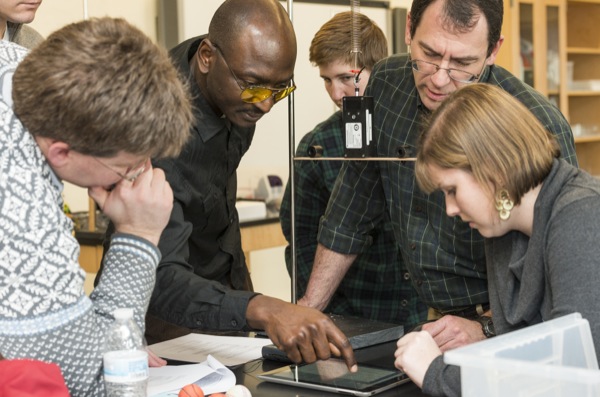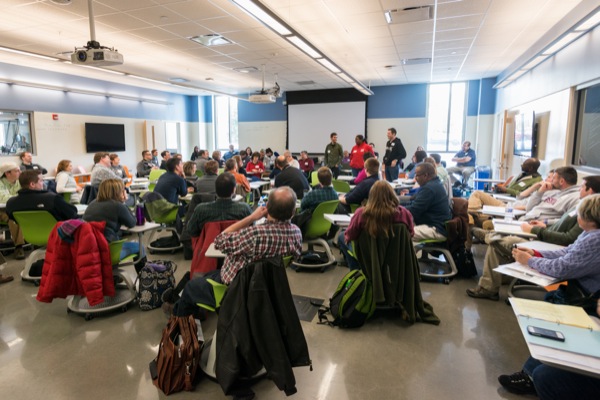


STEM connections
Math, science teachers come together at UD for interdisciplinary lessons
1:51 p.m., Feb. 10, 2014--At some of Delaware's high schools, math and science teachers from different disciplines don't know each other, even when they share the same hallways.
At Newark High School, that's in part because one teacher is new this year. At Mount Pleasant, one science teacher's classroom is in the basement. At other schools, time and resources are limited; biology teachers stick with biology teachers and chemistry teachers stick with chemistry teachers.
Campus Stories
From graduates, faculty
Doctoral hooding
But on a recent February day, many of these teachers came together as teams at the University of Delaware’s Interdisciplinary Science and Engineering Laboratory (ISE Lab) to take part in the two-day Practicing the STEM Practices Winter Institute. One of the goals was to help break down the walls between their fields.
“Biology, chemistry, physics and math are interdisciplinary, but in our schools they tend to stay in silos,” said John Jungck, UD professor and director of the DuPont Science Learning Laboratories, the instructional wing of ISE Lab. Jungck also is the co-leader of the two-year Delaware Department of Education Mathematics and Science Partnership (MSP) grant that made the institute possible.
Over the course of two days, teams from 12 Delaware public and private high schools took part in activities, both in and out of laboratories, meant to bridge their fields.
“We are all scattered around the building, and this is the first time we get to sit together as a team,” Les McLean, a physics teacher at Concord High School, said of his fellow Concord teammates.
Preceptors at ISE Lab in biology, chemistry and physics worked hard to develop the activities in which the teachers took part.
In one, teams explored microbial fuel cells, combining biology, chemistry and physics. By the end, teachers were talking about how the technology could provide electric power off the grid, showing how another STEM field, engineering, was also relevant to the lesson.
On day two, teams of teachers from different schools scattered white and black beans onto a square resembling a checkerboard. The beans represented rabbits and foxes, and the teams were modeling the population dynamics of the two species, whether each species lived or died in the presence of the other.
“It’s a way of understanding a complex situation and breaking it apart,” said Ursuline Academy chemistry teacher Kate McEvoy, while Chuck Halfen, a science specialist at Newark High, showed off the population graphs the team had made.
For Mary O'Connell, a math teacher at Tatnall Upper School, the activity was something she thought could be easily incorporated into classrooms, despite the short window of time many teachers have to work within.
“In little things like this there is so much meat,” O'Connell said. “That’s what’s great about being here. We’re picking up a lot of these little things we can use.”
When all 60 teachers came together to share their results monitoring the numbers of foxes and rabbits in relation to one another, the concept of coupled oscillations became clear. The numbers of each animal fluctuated in relation to one another in the ecological model.
Later, each discipline split up. In the biology lab, teachers studied the population dynamics between paramecium and didinium under a microscope. The chemistry teachers solved the chemical reaction that caused reversible color changes in a solution. The physics teachers used a Wilberforce pendulum to examine the dynamics between vertical motion and horizontal rotation.
All were examples of coupled oscillations; the same mathematical principle was common to all three fields.
Chris Wellborn, a physics teacher at William Penn High School, remained a bit skeptical about how the strategies could be helpful to him and his colleagues.
“The challenges are finding common students and making it meaningful,” said Wellborn.
The William Penn team was enthusiastic about the concepts it was learning at UD, but said school administrators would need to be understanding of a comprehensive STEM approach and the effect wouldn't be as strong if students weren't shared between them.
“I would love my classroom to be a lab for academics,” said Joe English, technology education teacher at William Penn. “If we can work as a group and be supported, I think we can knock this out of the park.”
Helping the teams do so is the goal of the MSP grant. This summer, teachers and students from their schools will return to UD to reinforce and enhance the concepts learned in the winter.
“Summer is when the magic happens,” said Jon Manon, director of the UD Mathematics and Science Education Resource Center and co-director on the MSP grant. Manon and Jungck want teachers to see the University as a long-term resource.
The ability to engage in interdisciplinary problem-based learning, to ask questions and find solutions through inquisitive study and experimentation are the foundations of both national Next Generation Science Standards and Common Core State Standards.
William Penn teachers already know these ideas work. When students in Armando Caro's mathematics class struggled to understand a curve known as a cycloid, he and English teamed up to build an actual model. Suddenly, the students had lots of questions.
“It generated math questions, physics questions, engineering questions from the students,” said Caro. “A lot of the students found the history fascinating.”
And that's exactly what students need to excel in STEM.
“That’s what learning is: Answer your own questions,” said English.
Article by Kelly April Tyrrell
Photos by Kathy F. Atkinson and Evan Krape










